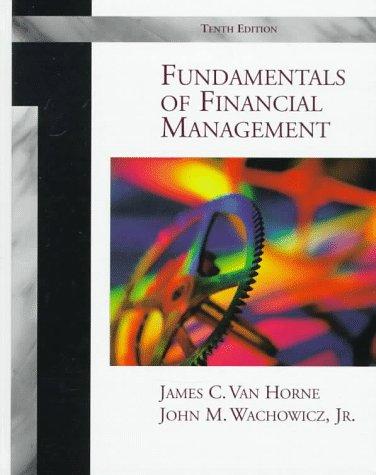Question
An airline was looking to add two additional aircraft to its fleet of over 200 airplanes. The purchase price for each new airplane would be
An airline was looking to add two additional aircraft to its fleet of over 200 airplanes. The purchase price for each new airplane would be $125 million. Leasing could be an option, however. In this case, a 15-year lease would be quarterly payments of $4 million for each airplane. This payment would be in arrears (like your home mortgage payment). Leasing may be good solution for this airline because of a net operating loss it has experienced. They had $2.5 billion of net operating loss to carry forward. These losses during this time were only allowed to be carried forward for a maximum of 20 years. During the period, the airlines capitalization was (in millions): Long Term Bonds $1,352 Capitalized leases 306 Total long-term debt $1,658 Preferred Stock 283 Stockholders equity 305 Total long-term capitalization $2,246 Short-term debt 221 Total capitalization $2,467 The airlines cost of fully secured 15-year debt was 10% (80% of the value of collateral). Its cost of unsecured 15-year debt was 12% and its WACC was 15%. The airline was uncertain at the time about the residual value of the airplanes at the end of the lease period. They therefore estimated the following possible values and probabilities: Residual value
| ($ millions) | 10 | 15 | 20 | 25 | 30 | 35 | 40 | 45 | 50 |
| Probability | 5 | 10 | 10 | 15 | 20 | 15 | 10 | 10 | 5 |
Questions 1. Calculate the net advantage to leasing. Use the expected residual value residual value and assume the airline can use all the tax benefits of ownership. The tax rate at the time was 40%. Assume straight-line depreciation to the expected residual value. 2. Calculate the net advantage to leasing. Assume the airline cannot use any of the tax benefits of ownership and the residual value is (i) the expected residual value, (ii) $50 million, and ($100 million). 3. Determine the residual value that would make the net advantage to leasing equal to zero, assuming the airline cannot use any tax benefits of ownership. 4. Suppose the airline believes it will not be in a tax paying position for a decade or longer. Should it lease, borrow, or buy? 5. Suppose the airline believes it will not be in a tax-paying position for a decade or longer, and this lease includes the option to terminate the lease at any time without penalty. Should it lease, borrow, or buy? 6. Use any net advantage to leasing (NAL) formula you prefer (this will require research) Determine the cost per airplane and in total. Remember these are quarterly payments over 15 years, so the n would be 60 not 15. 7. Assume the airline will use the 80% value on fully secured debt. Calculate the probabilities for some of the questions to determine the salvage value. Remember the tax rate and the tax deduction.
Step by Step Solution
There are 3 Steps involved in it
Step: 1

Get Instant Access to Expert-Tailored Solutions
See step-by-step solutions with expert insights and AI powered tools for academic success
Step: 2

Step: 3

Ace Your Homework with AI
Get the answers you need in no time with our AI-driven, step-by-step assistance
Get Started


